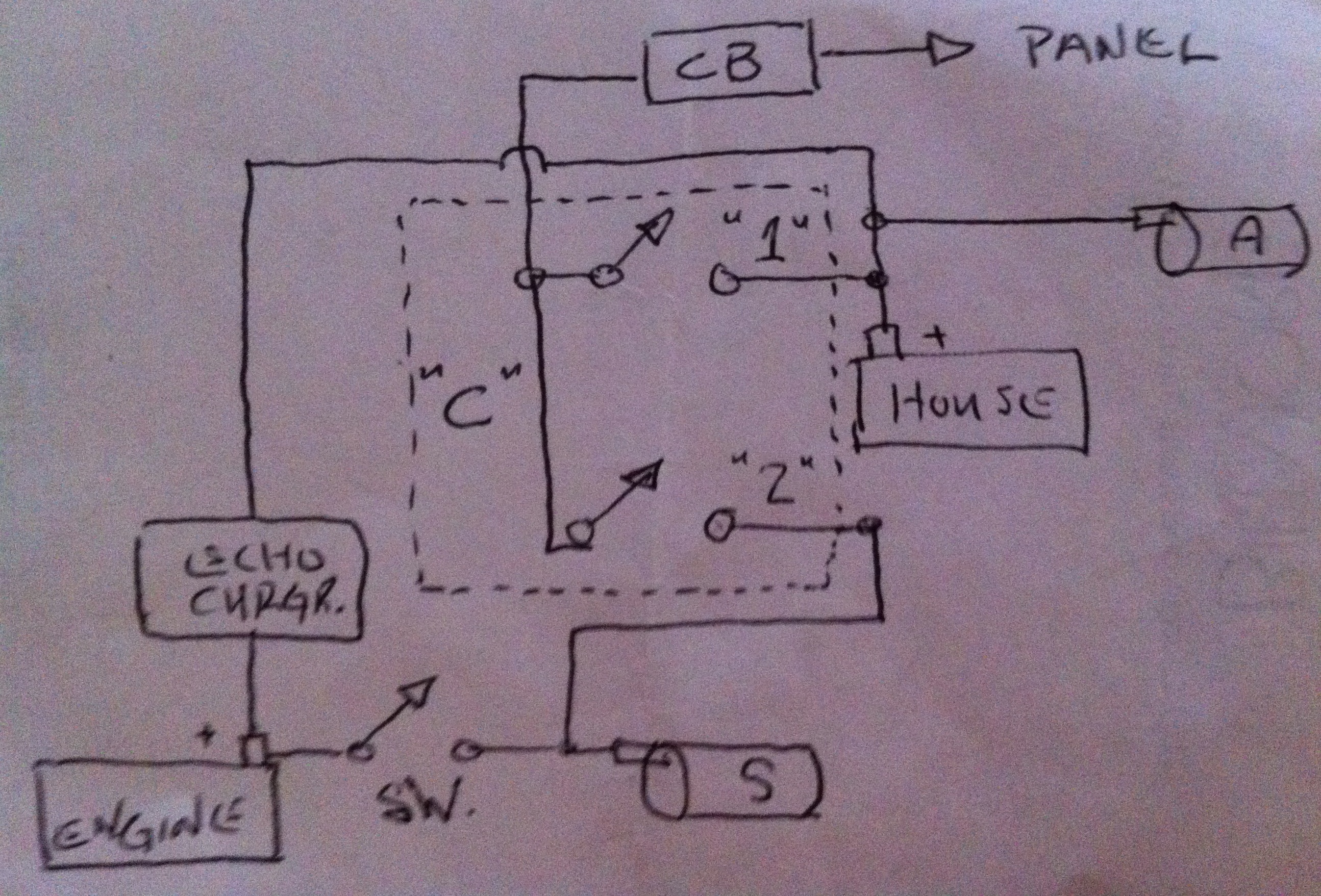The age old question of multiple house banks, and alternating use, vs. one single contiguously wired house bank comes up frequently. Years ago (60's & early 70's), when on-board DC consumption was much lower, the general belief, not really backed up by any critical thinking in those days, was to alternate bank use. In doing so boat owners quickly found battery life suffering and charging of multiple banks quite inefficient due to the amount of time needed to properly absorb multiple banks.
This post assumes the vessel has a start bank or start/reserve bank on-board and this discussion is only regarding the house bank.
The benefits to a single large hard wired bank are many, where the benefits to multiple on-board house banks are few to non-existent. There are however considerations for wiring and isolation that owners can also consider.
The question is not one of the physical amount of batteries on-board but rather a question of how these batteries are wired or used as a BANK and how they are charged.
For example having three individual banks on-board, HOUSE 1, HOUSE 2 and a STARTING bank, only serves to yield poorer house bank cycle life.
What about a windlass bank?
It's really pretty hard to justify a bow-bank on most sub 42' vessels, thus most sub 42' +/- boats are going to be better served by just two banks. A contiguously wired house bank and a start or start/reserve bank.
I believe Nigel Calder did an excellent job explaining the basics so I will start with his take on the subject.
IS IT BETTER TO HAVE ONE OR TWO BATTERY BANKS FOR HOUSE USE?
Begin Quote = Nigel Calder
"The popular arrangement of having two house banks alternated in use needs scrutiny before I go any further.
LIFE CYCLES: As we have seen, the life expectancy of a battery in cycling service is directly related to the depth to which it is discharged at each cycle - the greater the depth of discharge, the shorter the battery’s life.
This relationship between depth of discharge and battery life is NOT linear. As the depth of discharge increases, a battery’s life expectancy is disproportionately shortened. A given battery may cycle through 10% of its capacity 2,000 times, 50% of its capacity 300 times and 100% of its capacity around 100 times.
Let’s say, for arguments sake, that a boat has two 200-ah battery banks, alternated from day to day, with a daily load of 80 Ah. Each bank will be discharged by 40% (80 Ah of one of the two 200 Ah banks) of its capacity before being recharged. The batteries will fail after 380 cycles, which is 760 days (since each is used every other day). If the two banks had been wired in parallel, to make a single 400 Ah battery bank, this bank would have been discharged by 20% of capacity every day, with a life expectancy of 800 days, a 5% increase in life expectancy using exactly the same batteries!
But now let’s double the capacity of the batteries, so that the boat has either two 400 Ah banks, or a single 800 Ah bank, but with the same 80 Ah daily load. The two separate banks will be cycling through 20% of capacity every other day, resulting in a total life expectancy of 1,600 days. Doubling the size of the battery banks in relation to the load has produced a 210% increase in life expectancy. The single 800 Ah bank will be cycling through 10% of capacity every day, resulting in a life expectancy of 2,000 days - a 25% increase in life expectancy over the two (400 Ah) banks, and a 250% increase in life expectancy over the single 400 Ah battery bank!
There are two immediate conclusions to be drawn from these figures:
1. For a given total battery capacity, wiring the (house) batteries into a single high capacity bank, rather than having them divided into two alternating banks, will result in a longer overall life expectancy for the batteries.
2. All other things being equal, any increase in the overall capacity of a battery bank will produce a disproportionate increase in its life expectancy (through reducing the depth of discharge at each cycle)."
End Quote:
While Nigel does an excellent job with this, and keeps it simple, there is really some more detail to it.
Why one large bank is best for reasons beyond even what Nigel Calder has touched on.
#1 It is simply more efficient to charge one bank rather than two unless your using 100% free energy, and you have lots of excess time to on your hands. For a cruising boat using solar, your charging time is not really unlimited. Even then, with so called free energy, "finish charging", defined as getting back to 100% SOC, with two banks is considerably less efficient due to the longevity of the time needed, during the charge acceptance decline.and inordinate amount of time "finish charging" a lead acid banks takes. It is actually quite rare on a cruising sailboat to be able to get a house bank to a true 100% SOC in one solar day. At high states of charge the batteries become horribly inefficient at storing energy. The Coulombic efficiency can get as bad as 40% - 50% inefficient above 95% SOC and even worse once you're over 97% SOC. This means a lot of your solar energy is getting wasted pushing the batteries upward towards 100%. Charging two separate banks means your high SOC inefficiencies essentially double and require double the charging hours.
#2 A larger contiguously wired bank will not be as dramatically affected by the Peukert effect. Your batteries are rated at a 20 hour discharge rate and for a 100Ah battery this would be a 5A load. By increasing the bank size you'll actually get more usable Ah capacity out of a larger bank, with the same DC load, than you do with a smaller bank with the same DC load. Once again we are gaining usable Ah capacity, rather than losing it, when we use a single large house bank.
The Peukert Effect:
A bank with a Peukert of 1.3 and an average load of 8A looks like this, if you were to draw the bank to 10.5V and use all the capacity.
Note: Increases in bank Ah capacity, at slow rate discharge, are from mathematical formula and usually do not = actual chemical capacity. Ah gains at low discharge rates can range from 105% to 123% of Ah capacity or more. The bank illustrated in red has us losing Ah capacity and in green gaining usable Ah capacity.
100Ah bank, Peukert 1.3, Average House Load 8A = 87Ah's
200Ah bank, Peukert 1.3, Average House Load 8A = 213Ah's
400Ah bank, Peukert 1.3, Average House Load 8A = 526 Ah's
600Ah bank, Peukert 1.3, Average House Load 8A = 892Ah's
800Ah bank, Peukert 1.3, Average House Load 8A = 1296 Ah's
The jump from a single 100Ah battery with an average load of 8A to a 200Ah bank with the same 8A load goes from 87Ah's of usable capacity, yes 12% less usable Ah's for the 100Ah battery, to 213 Ah's with the 200Ah bank. As you grow the bank, and keep the load the same, the excess usable capacity continues to grow. This also means higher SOC's at the end of each day and considerably shallower discharges. Shallower discharging each day means less sulfation build up and longer bank cycle life.
The image below is an actual hourly rate chart from Rolls Battery. It illustrates the Peukert Effect extremely well. The usable capacity of this battery at a load of 4.86A, vs. the 20 hour rated capacity load of 18.75A is HUGE.! A 4.86A load on a 375Ah bank is right in the range of how we use house banks on boats..
Boaters rarely if ever load their house banks at the 20 hour rate as an "average" unless the bank is too small or your a multiple house bank user. The 20 hour rate would be an average load of 20A on a 400Ah bank or 5A on a 100Ah bank. The reality is that the average boater with a 400Ah bank is often pulling just 2A - 8A as an average load. This also means that with a contiguously wired 400Ah bank, your real usable capacity is closer to 500Ah's +/-..
By using a house bank split in half you lose much of these Peukert gains, especially on thick plate deep cycle batteries which have higher Peukert coefficients..
Rolls Battery Hour Rate Chart CH375:
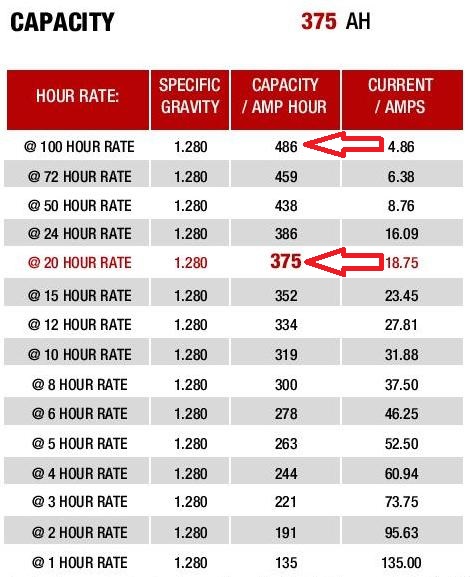
This means that your bank will have even shallower discharges, not just because it is one large bank, but if the load stays the same, and you increase bank size, you will actually get more usable Ah capacity out of the larger bank due to the Peukert effect than you will from two smaller banks.
#3 A grossly overlooked benefit of a larger bank is the banks ability to support higher voltages for your equipment, and to do so for longer periods of time. On-board equipment such as heaters and refrigeration run more efficiently at higher voltages, windlasses will perform better, thrusters perform better, inverters will work better as will just about everything you have that runs of 12V DC. Starter motors also perform better with less voltage sag during cranking. This means faster starts and less wear and tear on the starter motor.
With a single hard wired larger bank you're not only combining Ah's of capacity but, you also combine cranking amperage. A single larger house bank, sized typically for today's DC usage, even at 50% SOC, will almost always start the motor with less voltage sag, than will a smaller bank at a higher state of charge.
#4 By correctly wiring them contiguously in parallel, positive off the first battery and negative off the opposite end battery the batteries remain better balanced over their life. Maintaining balanced batteries leads to longer battery life.
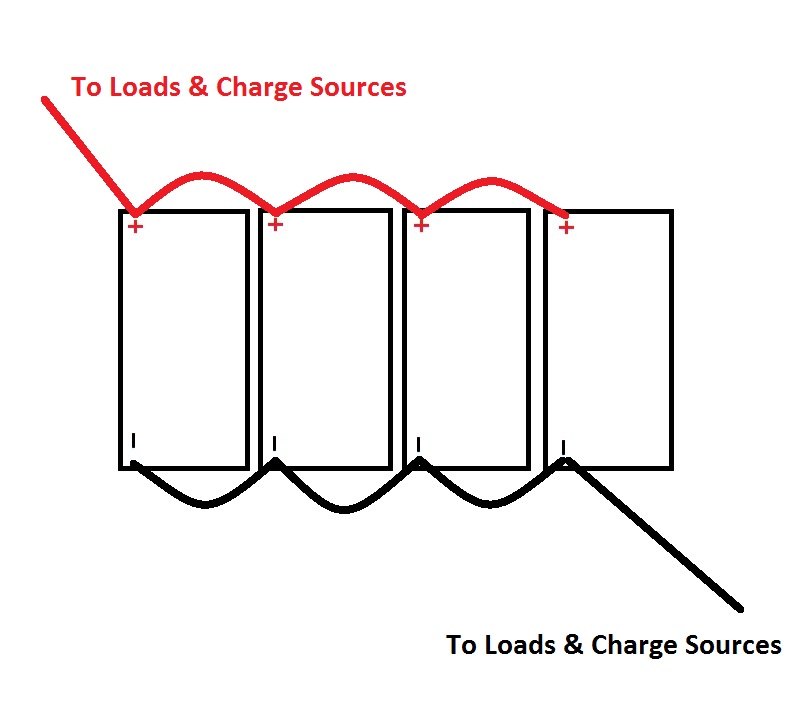
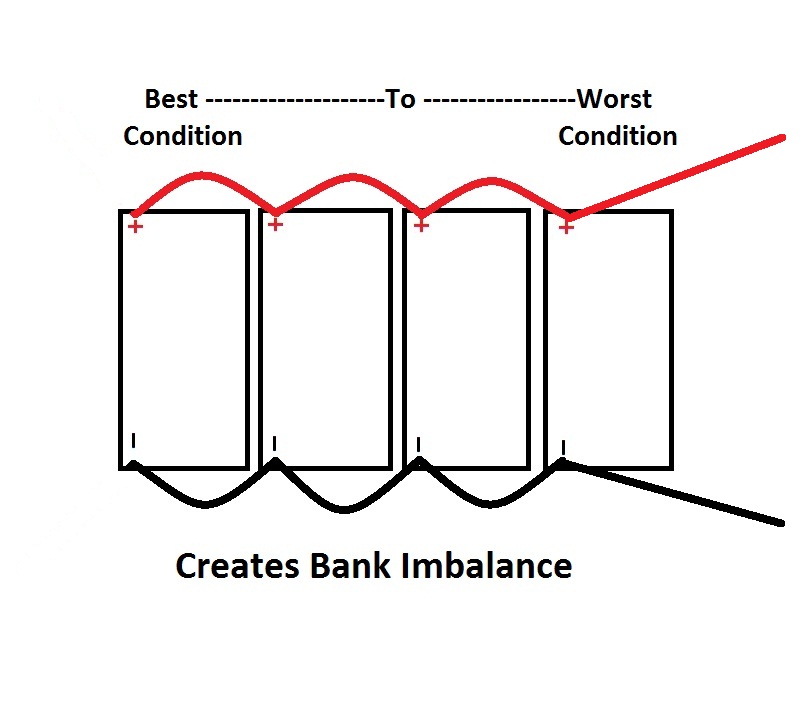
#5 The shallower the discharges, for the same average house load, the less sulfation you create and this is exactly why a single large bank, cycled less deeply, yields more lifetime real-world cycles.
#6 Wiring *one large contiguous bank, either parallel for 12V batteries or series/parallel for 6V batteries, allows for more precision in keeping the bank wiring and current flowing through the bank in a balanced manner.
#7 If using a main battery switch in BOTH, and "I always run them in parallel" and you have a battery monitor you need to consider the OFF position of the switch. When the bank is OFF one battery will always have the parisitic loads of the vessel being carried by it such as bilge pumps, stereo memory, fume detectors etc.. When you flip the bank back on your Ah counter is now skewed even more than normal. Bottom line you cannot accurately Coulomb count/monitor a bank that gets isolated repeatedly.
*NOTE: This does not mean that you can't have a means of emergency battery isolation such as, wrenches, removable fuses or the diagram shown below.
If using the diagram below please remember that these "emergency isolation switches" should ideally remain out of sight of guests, such as physically mounted inside the battery compartment or behind a bulkhead as close to the bank as possible. These switches should always remain in the ON position. The only time these switches are used is when there is a battery failure within the bank or for winter storage.
In this diagram only the house bank ON/OFF switch is visible to vessel occupants. The isolation switches & busbar are mounted inches from the battery bank with the main fuse just off the busbar. The isolation switches are only used when physically working on the bank, there is a bank failure or for winter storage.
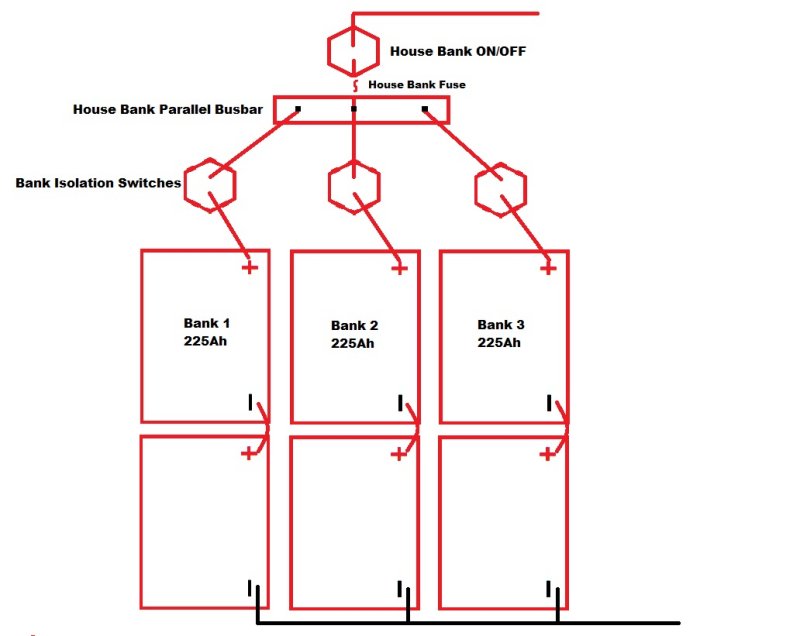
#8 Splitting, via a switch, or alternating a house banks use makes for a battery monitoring nightmare when using a Coulomb counting battery monitor.
To summarize, a single large bank for house use means:
*Overall charging efficiency is better
*Cycle life is considerably better
*The batteries ability to support voltage is much better
*You'll get more usable capacity at the same average load than the 20 hour rate suggests
*You'll create less sulfation with shallow cycles than you do with deep cycles.
Multiple Banks & Battery Monitors:
If you are looking into a battery monitor they fall into two basic categories at this point.
Coulomb Counters:
These devices count Ah's and require routine user input to remain anywhere close to being accurate for SOC. They can drift out of sync with the bank and become inaccurate over time if you don't keep up with the programming. There are a lot of poor Coulomb counting monitors out there so be sure to get one that allows you to program the Peukert's constant, charge efficiency etc.. If you are committed to splitting a house bank you'll really need two battery monitors, one for each bank. If you own an Ah counter please take the time to read and comprehend the article below:
Making Your Battery Monitor More Accurate (LINK)
Self learning Battery Monitors:
Balmar Smartgauge = The Smart Gauge does not use an ammeter and is quite amazingly accurate, but it only shows voltage and % SOC. Connect two wires, program the battery type and then simply leave it connected. It gets more accurate over time. It does however need to remain connected to the house bank 100% of the time or it can get out of accuracy. In order for a Smart Gauge to work alternating house banks is not an option.
Balmar SG200 = The Balmar SG200 is a shunt based self learning battery monitor that can show current, voltage, history, battery state of health (SOH) and battery state of charge (SOC). It self learns the bank and remains accurate without human intervention. It is also the only one that can use multiple shunts with one display.
Both types of monitors will need to be hard wired to the bank with no ability to switch or split the house bank.
This post assumes the vessel has a start bank or start/reserve bank on-board and this discussion is only regarding the house bank.
The benefits to a single large hard wired bank are many, where the benefits to multiple on-board house banks are few to non-existent. There are however considerations for wiring and isolation that owners can also consider.
The question is not one of the physical amount of batteries on-board but rather a question of how these batteries are wired or used as a BANK and how they are charged.
For example having three individual banks on-board, HOUSE 1, HOUSE 2 and a STARTING bank, only serves to yield poorer house bank cycle life.
What about a windlass bank?
It's really pretty hard to justify a bow-bank on most sub 42' vessels, thus most sub 42' +/- boats are going to be better served by just two banks. A contiguously wired house bank and a start or start/reserve bank.
I believe Nigel Calder did an excellent job explaining the basics so I will start with his take on the subject.
IS IT BETTER TO HAVE ONE OR TWO BATTERY BANKS FOR HOUSE USE?
Begin Quote = Nigel Calder
"The popular arrangement of having two house banks alternated in use needs scrutiny before I go any further.
LIFE CYCLES: As we have seen, the life expectancy of a battery in cycling service is directly related to the depth to which it is discharged at each cycle - the greater the depth of discharge, the shorter the battery’s life.
This relationship between depth of discharge and battery life is NOT linear. As the depth of discharge increases, a battery’s life expectancy is disproportionately shortened. A given battery may cycle through 10% of its capacity 2,000 times, 50% of its capacity 300 times and 100% of its capacity around 100 times.
Let’s say, for arguments sake, that a boat has two 200-ah battery banks, alternated from day to day, with a daily load of 80 Ah. Each bank will be discharged by 40% (80 Ah of one of the two 200 Ah banks) of its capacity before being recharged. The batteries will fail after 380 cycles, which is 760 days (since each is used every other day). If the two banks had been wired in parallel, to make a single 400 Ah battery bank, this bank would have been discharged by 20% of capacity every day, with a life expectancy of 800 days, a 5% increase in life expectancy using exactly the same batteries!
But now let’s double the capacity of the batteries, so that the boat has either two 400 Ah banks, or a single 800 Ah bank, but with the same 80 Ah daily load. The two separate banks will be cycling through 20% of capacity every other day, resulting in a total life expectancy of 1,600 days. Doubling the size of the battery banks in relation to the load has produced a 210% increase in life expectancy. The single 800 Ah bank will be cycling through 10% of capacity every day, resulting in a life expectancy of 2,000 days - a 25% increase in life expectancy over the two (400 Ah) banks, and a 250% increase in life expectancy over the single 400 Ah battery bank!
There are two immediate conclusions to be drawn from these figures:
1. For a given total battery capacity, wiring the (house) batteries into a single high capacity bank, rather than having them divided into two alternating banks, will result in a longer overall life expectancy for the batteries.
2. All other things being equal, any increase in the overall capacity of a battery bank will produce a disproportionate increase in its life expectancy (through reducing the depth of discharge at each cycle)."
End Quote:
While Nigel does an excellent job with this, and keeps it simple, there is really some more detail to it.
Why one large bank is best for reasons beyond even what Nigel Calder has touched on.
#1 It is simply more efficient to charge one bank rather than two unless your using 100% free energy, and you have lots of excess time to on your hands. For a cruising boat using solar, your charging time is not really unlimited. Even then, with so called free energy, "finish charging", defined as getting back to 100% SOC, with two banks is considerably less efficient due to the longevity of the time needed, during the charge acceptance decline.and inordinate amount of time "finish charging" a lead acid banks takes. It is actually quite rare on a cruising sailboat to be able to get a house bank to a true 100% SOC in one solar day. At high states of charge the batteries become horribly inefficient at storing energy. The Coulombic efficiency can get as bad as 40% - 50% inefficient above 95% SOC and even worse once you're over 97% SOC. This means a lot of your solar energy is getting wasted pushing the batteries upward towards 100%. Charging two separate banks means your high SOC inefficiencies essentially double and require double the charging hours.
#2 A larger contiguously wired bank will not be as dramatically affected by the Peukert effect. Your batteries are rated at a 20 hour discharge rate and for a 100Ah battery this would be a 5A load. By increasing the bank size you'll actually get more usable Ah capacity out of a larger bank, with the same DC load, than you do with a smaller bank with the same DC load. Once again we are gaining usable Ah capacity, rather than losing it, when we use a single large house bank.
The Peukert Effect:
A bank with a Peukert of 1.3 and an average load of 8A looks like this, if you were to draw the bank to 10.5V and use all the capacity.
Note: Increases in bank Ah capacity, at slow rate discharge, are from mathematical formula and usually do not = actual chemical capacity. Ah gains at low discharge rates can range from 105% to 123% of Ah capacity or more. The bank illustrated in red has us losing Ah capacity and in green gaining usable Ah capacity.
100Ah bank, Peukert 1.3, Average House Load 8A = 87Ah's
200Ah bank, Peukert 1.3, Average House Load 8A = 213Ah's
400Ah bank, Peukert 1.3, Average House Load 8A = 526 Ah's
600Ah bank, Peukert 1.3, Average House Load 8A = 892Ah's
800Ah bank, Peukert 1.3, Average House Load 8A = 1296 Ah's
The jump from a single 100Ah battery with an average load of 8A to a 200Ah bank with the same 8A load goes from 87Ah's of usable capacity, yes 12% less usable Ah's for the 100Ah battery, to 213 Ah's with the 200Ah bank. As you grow the bank, and keep the load the same, the excess usable capacity continues to grow. This also means higher SOC's at the end of each day and considerably shallower discharges. Shallower discharging each day means less sulfation build up and longer bank cycle life.
The image below is an actual hourly rate chart from Rolls Battery. It illustrates the Peukert Effect extremely well. The usable capacity of this battery at a load of 4.86A, vs. the 20 hour rated capacity load of 18.75A is HUGE.! A 4.86A load on a 375Ah bank is right in the range of how we use house banks on boats..
Boaters rarely if ever load their house banks at the 20 hour rate as an "average" unless the bank is too small or your a multiple house bank user. The 20 hour rate would be an average load of 20A on a 400Ah bank or 5A on a 100Ah bank. The reality is that the average boater with a 400Ah bank is often pulling just 2A - 8A as an average load. This also means that with a contiguously wired 400Ah bank, your real usable capacity is closer to 500Ah's +/-..
By using a house bank split in half you lose much of these Peukert gains, especially on thick plate deep cycle batteries which have higher Peukert coefficients..
Rolls Battery Hour Rate Chart CH375:

This means that your bank will have even shallower discharges, not just because it is one large bank, but if the load stays the same, and you increase bank size, you will actually get more usable Ah capacity out of the larger bank due to the Peukert effect than you will from two smaller banks.
#3 A grossly overlooked benefit of a larger bank is the banks ability to support higher voltages for your equipment, and to do so for longer periods of time. On-board equipment such as heaters and refrigeration run more efficiently at higher voltages, windlasses will perform better, thrusters perform better, inverters will work better as will just about everything you have that runs of 12V DC. Starter motors also perform better with less voltage sag during cranking. This means faster starts and less wear and tear on the starter motor.
With a single hard wired larger bank you're not only combining Ah's of capacity but, you also combine cranking amperage. A single larger house bank, sized typically for today's DC usage, even at 50% SOC, will almost always start the motor with less voltage sag, than will a smaller bank at a higher state of charge.
#4 By correctly wiring them contiguously in parallel, positive off the first battery and negative off the opposite end battery the batteries remain better balanced over their life. Maintaining balanced batteries leads to longer battery life.


#5 The shallower the discharges, for the same average house load, the less sulfation you create and this is exactly why a single large bank, cycled less deeply, yields more lifetime real-world cycles.
#6 Wiring *one large contiguous bank, either parallel for 12V batteries or series/parallel for 6V batteries, allows for more precision in keeping the bank wiring and current flowing through the bank in a balanced manner.
#7 If using a main battery switch in BOTH, and "I always run them in parallel" and you have a battery monitor you need to consider the OFF position of the switch. When the bank is OFF one battery will always have the parisitic loads of the vessel being carried by it such as bilge pumps, stereo memory, fume detectors etc.. When you flip the bank back on your Ah counter is now skewed even more than normal. Bottom line you cannot accurately Coulomb count/monitor a bank that gets isolated repeatedly.
*NOTE: This does not mean that you can't have a means of emergency battery isolation such as, wrenches, removable fuses or the diagram shown below.
If using the diagram below please remember that these "emergency isolation switches" should ideally remain out of sight of guests, such as physically mounted inside the battery compartment or behind a bulkhead as close to the bank as possible. These switches should always remain in the ON position. The only time these switches are used is when there is a battery failure within the bank or for winter storage.
In this diagram only the house bank ON/OFF switch is visible to vessel occupants. The isolation switches & busbar are mounted inches from the battery bank with the main fuse just off the busbar. The isolation switches are only used when physically working on the bank, there is a bank failure or for winter storage.

#8 Splitting, via a switch, or alternating a house banks use makes for a battery monitoring nightmare when using a Coulomb counting battery monitor.
To summarize, a single large bank for house use means:
*Overall charging efficiency is better
*Cycle life is considerably better
*The batteries ability to support voltage is much better
*You'll get more usable capacity at the same average load than the 20 hour rate suggests
*You'll create less sulfation with shallow cycles than you do with deep cycles.
Multiple Banks & Battery Monitors:
If you are looking into a battery monitor they fall into two basic categories at this point.
Coulomb Counters:
These devices count Ah's and require routine user input to remain anywhere close to being accurate for SOC. They can drift out of sync with the bank and become inaccurate over time if you don't keep up with the programming. There are a lot of poor Coulomb counting monitors out there so be sure to get one that allows you to program the Peukert's constant, charge efficiency etc.. If you are committed to splitting a house bank you'll really need two battery monitors, one for each bank. If you own an Ah counter please take the time to read and comprehend the article below:
Making Your Battery Monitor More Accurate (LINK)
Self learning Battery Monitors:
Balmar Smartgauge = The Smart Gauge does not use an ammeter and is quite amazingly accurate, but it only shows voltage and % SOC. Connect two wires, program the battery type and then simply leave it connected. It gets more accurate over time. It does however need to remain connected to the house bank 100% of the time or it can get out of accuracy. In order for a Smart Gauge to work alternating house banks is not an option.
Balmar SG200 = The Balmar SG200 is a shunt based self learning battery monitor that can show current, voltage, history, battery state of health (SOH) and battery state of charge (SOC). It self learns the bank and remains accurate without human intervention. It is also the only one that can use multiple shunts with one display.
Both types of monitors will need to be hard wired to the bank with no ability to switch or split the house bank.

